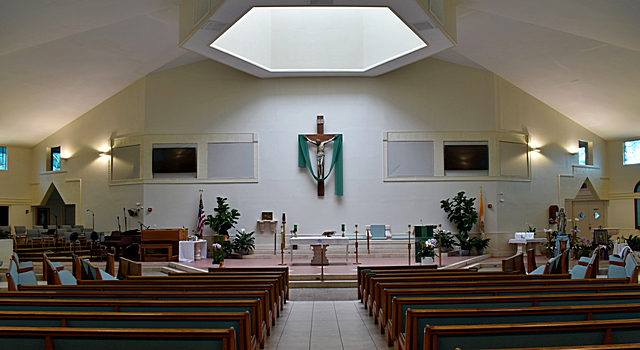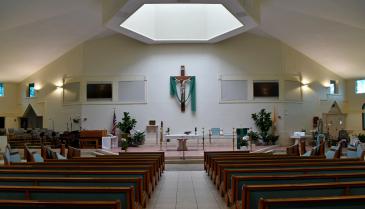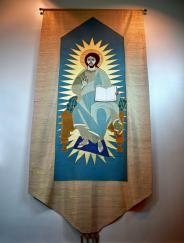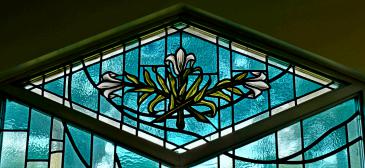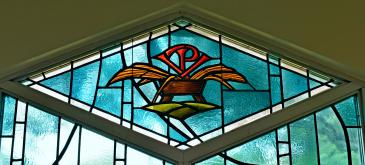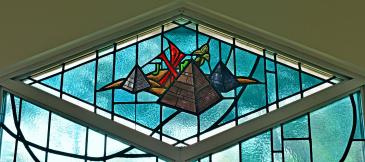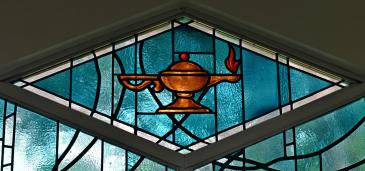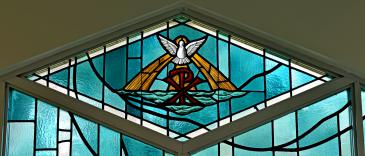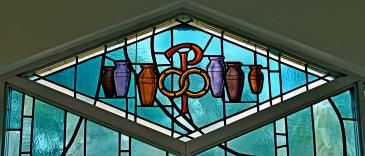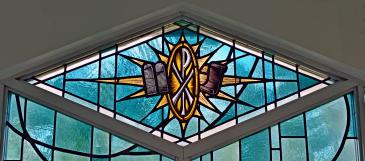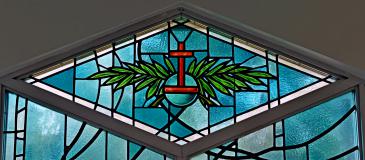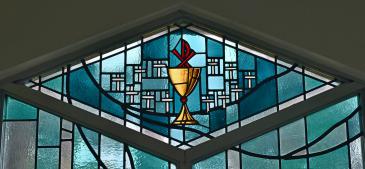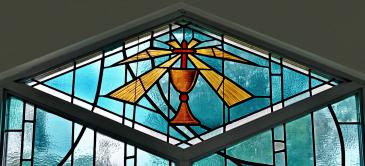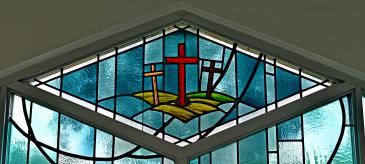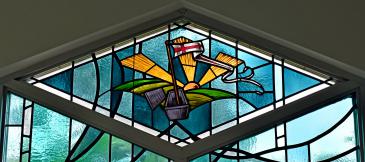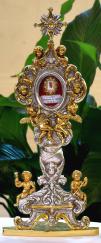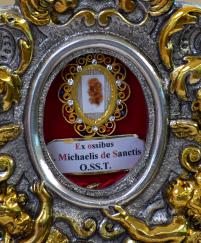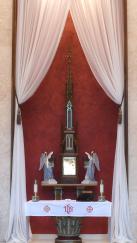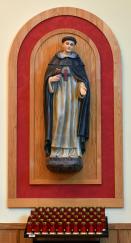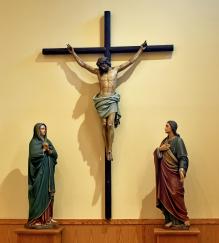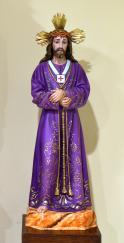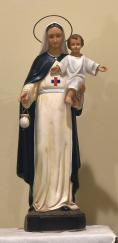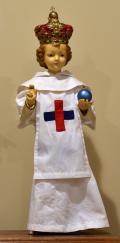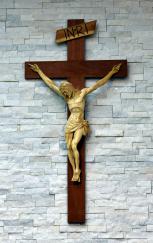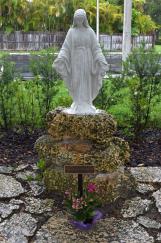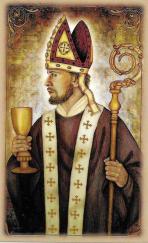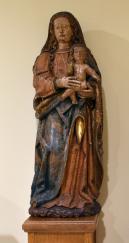By Jim Davis - Florida Catholic
Photography: Jim Davis
PALMETTO BAY | This month's featured parish has a double honorific: the rosary and its prayer, and a priest whose prayer made it to Broadway.
Our Lady of the Holy Rosary-St. Richard is the product of a merger of two parishes.Holy Rosary Parish began in Cutler Bay in 1959, the first parish established by Miami's first bishop, Coleman F. Carroll, who named it after his home church in Pittsburgh. St. Richard was established in 1969 in the nearby Coral Reef neighborhood.
The two parishes merged in 2010 and, together with Catholics worldwide, observe October as the Month of the Holy Rosary.
BORN DURING WARTIME
Paradoxically, the monthlong festival for the peaceful rosary prayer was born during wartime. In the 16th century Mediterranean, the Christian world was threatened by the Turkish Ottoman Empire, which massed a fleet off the coast of Greece.
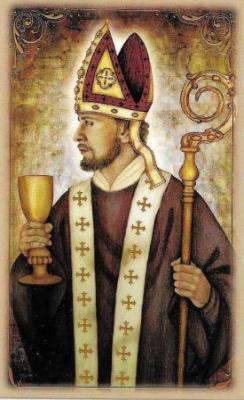
Photographer: Courtesy
St. Richard is depicted in this prayer card holding the chalice of wine that didn't spill after he dropped it.
A “Holy League” of Christian forces set out in 1571 to meet the larger Turkish fleet. Pope Pius V called for all Catholics to pray the rosary for victory. The flagships of the Holy League also flew banners showing a crucified Christ and Our Lady of Guadalupe.
The resulting battle destroyed much of the Ottoman fleet and saved Europe from being overrun. In gratitude, Pius the following year established a feast in honor of the Holy Rosary, on Oct. 7.
It was also in that month – on Oct. 13, 1917 – that Mary at Fatima, Portugal, declared herself “the Lady of the Rosary.” During her five months of appearances there, she called for praying the rosary for peace and the conversion of sinners.
THE GOSPEL IN SONG
The other parish namesake, St. Richard of Chichester, is best known for a Broadway song lyric – yet few who sing it even know his name.
It’s Day by Day, from the 1971 musical Godspell, based on the Gospel according to St. Matthew. Among the lyrics:
Day by Day
Day by Day
Oh, dear Lord, three things I pray
To see thee more clearly
Love thee more dearly
Follow thee more nearly
Day by Day
It’s fairly close to the prayer by the medieval English bishop:
O most merciful Redeemer, Friend, and Brother,
May we know thee more clearly,
Love thee more dearly,
And follow thee more nearly.
Richard needed lots of strength and guidance. Born in 1197 in what is now Droitwich, England, Richard had to contend with opposition all his life. He was a child when his parents died, and his guardians nearly ruined the family farm.
He and his elder brother took over the management and saved the farm. His brother offered him the estate, but Richard declined, choosing education.
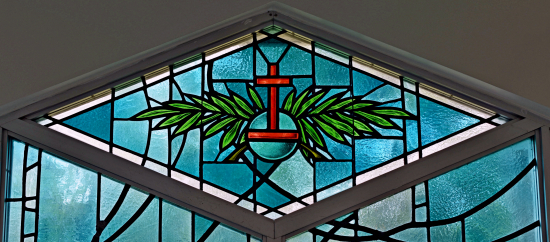
Photographer: Jim Davis | FC
Christ the King is honored in the Palm Sunday window, with an orb standing for rulership of the world. The palms represent the fronds laid at Jesus' feet in the Triumphal Entry.
Richard became a distinguished scholar at Oxford, then Paris and Bologna, then returned to Oxford as chancellor. It seemed like a good move when St. Edmund, the archbishop of Canterbury, asked Richard to become his chancellor.
But that move caught Richard in disputes between Pope Innocent IV and King Henry III. Both he and Edmund went into exile in France. Richard studied theology and was ordained in Orleans.
He caught the eye of the new archbishop of Canterbury, Boniface of Savoy, who appointed him as his chancellor. When the bishop of Chichester died, Boniface recommended Richard for the job. That infuriated Henry, who again blocked Richard’s appointment – this time by withholding the funds and estates due him.
For two years, Richard wandered penniless, living off donations and preaching wherever he could. Only when the pope threatened Henry with excommunication did the king lift the ban.
As bishop, Richard continued to live humbly. He didn’t eat meat and wore a scratchy hair shirt. He sold his gold and silver, giving the proceeds to the poor.
This success lasted only eight years. While en route to Dover to bless a new church, Richard took ill. He managed to finish the ceremony but died the next morning. He was declared a saint in 1262, and his feast day is April 3.
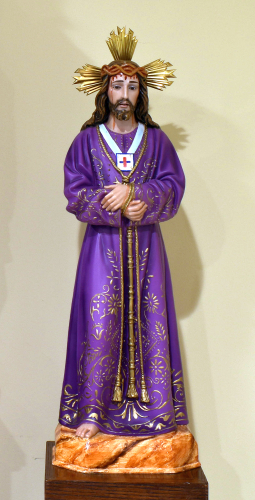
Photographer: Jim Davis | FC
Christ the Holy Redeemer is a replica of a statuette ransomed by Trinitarians in Morocco - along with 200 Christian slaves. His feast day is Oct. 23.
Many people, however, considered him a saint even in life, especially given his reputation for miracles.
In one story, his candle relit itself when others went out during a procession. In another story, he blessed fishermen, helping them catch fish. In the best-known anecdote, the bishop dropped a chalice during Mass – yet when he picked it up, he found no wine spilled.
St. Richard may never become a household name, but the musical that cites his prayer clearly has struck a chord. Godspell became a movie in 1972, with reworked versions of the play in 2000 and 2012.
THE PARISHES
The nucleus of Holy Rosary parish formed in 1955 as Cutler Bay women began carpooling children to Sacred Heart School in Homestead.
The parish grew to nearly 2,000 families and 500 students, and it began building a new complex – a project that took more than three years because of Hurricane Andrew in 1992. However, the roof leaked and the foundation was undermined, and the church was declared unsafe and finally demolished in 2007.
Meanwhile, St. Richard parish was growing in the nearby Coral Reef neighborhood. A church building was finished in 1989, but it was likewise damaged by Hurricane Andrew. Members worshiped the week after the hurricane in the family center, catching rainwater in garbage pails.
St. Richard rebuilt its church and welcomed the congregants of Holy Rosary after the merger. Today, the combined parish includes the home of the former St. Richard, plus the former Holy Rosary School four miles away.
Two years after the merger, the parish came under the care of the Order of the Most Holy Trinity and of the Captives. The Trinitarians were founded in 1198 after a French priest, St. John de Matha, had a vision of Christ holding two captives by their hands.
John concluded that he was called to ransom Christians from the Moors, who were kidnapping and enslaving people. He and his mentor, St. Felix of Valois, began raising funds for the prisoners. Over the centuries, thousands were rescued and returned home.
As the order grew and spread, its scope broadened to schools, human rights, immigrants and in churches. Besides Holy Rosary-St. Richard, Trinitarians serve in parishes in New Jersey and Massachusetts.
